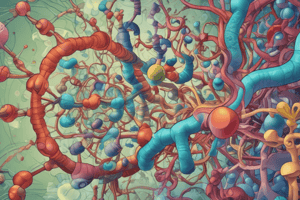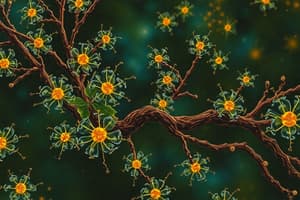Podcast
Questions and Answers
What is the primary function of carbohydrates in living organisms?
What is the primary function of carbohydrates in living organisms?
- Facilitate chemical reactions as enzymes
- Provide structural support in cell walls
- Act as a source of energy (correct)
- Serve as genetic material
Which of the following is a disaccharide?
Which of the following is a disaccharide?
- Fructose
- Sucrose (correct)
- Cellulose
- Glucose
What type of bond forms between monosaccharides to create polysaccharides?
What type of bond forms between monosaccharides to create polysaccharides?
- Glycosidic bond (correct)
- Peptide bond
- Hydrogen bond
- Ionic bond
Which carbohydrate is primarily involved in energy storage in animals?
Which carbohydrate is primarily involved in energy storage in animals?
Which characteristic distinguishes cellulose from starch?
Which characteristic distinguishes cellulose from starch?
Quina afirmació és correcta sobre els polisacàrids?
Quina afirmació és correcta sobre els polisacàrids?
Quina és la funció principal del glicogen en els animals?
Quina és la funció principal del glicogen en els animals?
Quin dels següents tipus de carbohidrats es considera un polisacàrid estructural?
Quin dels següents tipus de carbohidrats es considera un polisacàrid estructural?
Quin paper juguen els enllaços glicosídics en els carbohidrats?
Quin paper juguen els enllaços glicosídics en els carbohidrats?
Quina caracteristica diferencial tenen els monosacàrids?
Quina caracteristica diferencial tenen els monosacàrids?
Flashcards
Carbohydrate Functions
Carbohydrate Functions
Primary energy source; metabolic processes; structural components.
Disaccharide Examples
Disaccharide Examples
Sucrose, lactose, and maltose are formed by two monosaccharide units.
Glycogen
Glycogen
Energy storage in animals, found in the liver and muscle tissues.
Carbohydrates
Carbohydrates
Signup and view all the flashcards
Monosaccharides
Monosaccharides
Signup and view all the flashcards
Disaccharides
Disaccharides
Signup and view all the flashcards
Polysaccharides
Polysaccharides
Signup and view all the flashcards
Starch
Starch
Signup and view all the flashcards
Cellulose
Cellulose
Signup and view all the flashcards
Glycogen Utilization
Glycogen Utilization
Signup and view all the flashcards
Study Notes
Functions of Carbohydrates
- Serve as a primary energy source for living organisms.
- Play a crucial role in metabolic processes and structural components.
Disaccharide Examples
- Sucrose, lactose, and maltose are common examples of disaccharides, which are formed by two monosaccharide units.
Bonds in Polysaccharides
- Glycosidic bonds form between monosaccharides, linking them to create polysaccharides such as starch and glycogen.
Energy Storage in Animals
- Glycogen is the main carbohydrate involved in energy storage in animals, primarily found in the liver and muscle tissues.
Cellulose vs. Starch
- Cellulose consists of linear chains of glucose units with beta-glycosidic bonds, making it structurally distinct from starch, which has alpha-glycosidic bonds and is branched.
Carbohydrates Overview
- Carbohydrates are organic compounds consisting of carbon, hydrogen, and oxygen, commonly known as sugars and starches.
- They are categorized into three main types: monosaccharides, disaccharides, and polysaccharides.
Monosaccharides
- Monosaccharides are the simplest form of carbohydrates and function as the building blocks for more complex sugars.
- Examples include glucose (important energy source), fructose (found in fruits), and galactose.
- They typically have the general formula (CH2O)n where n is the number of carbon atoms.
Disaccharides
- Formed by the condensation reaction of two monosaccharides joined by glycosidic bonds.
- Common disaccharides include sucrose (glucose + fructose), lactose (glucose + galactose), and maltose (glucose + glucose).
- Hydrolysis of disaccharides produces their constituent monosaccharides.
Polysaccharides
- Composed of long chains of monosaccharide units linked together by glycosidic bonds.
- Key examples include starch (energy storage in plants), glycogen (energy storage in animals), and cellulose (structural component in plant cell walls).
- Polysaccharides can be branched or unbranched, affecting their solubility and digestibility.
Functions of Carbohydrates
- Serve as a primary energy source for living organisms.
- Play a vital role in cellular recognition and signaling through glycoproteins and glycolipids.
- Contribute to the structure of cells, particularly in plants with cellulose.
Dietary Sources
- Rich sources include fruits, vegetables, grains, and legumes.
- Simple carbohydrates (sugars) are quickly absorbed, while complex carbohydrates (starches) provide a slower, sustained release of energy.
Glycogen Storage and Utilization
- Glycogen is stored primarily in the liver and muscles and is broken down into glucose when energy is needed.
- Enzymes such as glycogen phosphorylase regulate the breakdown process, pivotal for energy management during physical activity.
Impact on Health
- Excessive consumption of carbohydrates, particularly simple sugars, can lead to health issues such as obesity and diabetes.
- A balanced intake of carbohydrates, focusing on complex carbohydrates, is essential for maintaining overall health and energy levels.
Studying That Suits You
Use AI to generate personalized quizzes and flashcards to suit your learning preferences.




